Menus
- Concept comparison of naked bikes, enduro, athletes and cruisers
- Concept comparison
- R1 engine with good response and load change behavior
- Even in third gear, all the machines drive around 150 km / h
- The main thing is that the overall system works
- Conclusion
- Ducati Diavel Carbon
- KTM 1190 Adventure
- MV Agusta Brutale 1090
- Yamaha YZF-R1
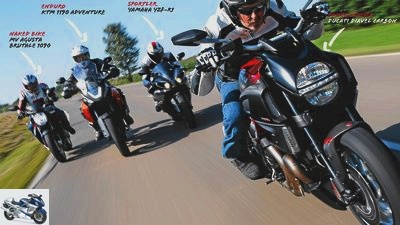
Monnich
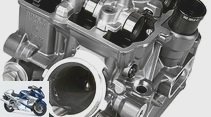
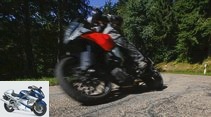
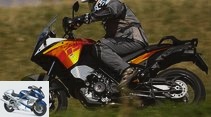
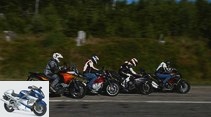
33 photos
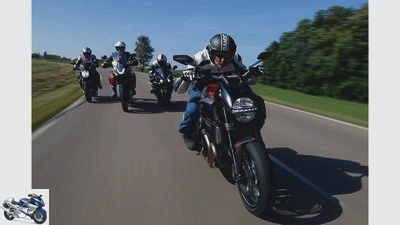
Monnich
1/33
In our concept comparison, we test the MV Agusta Brutale 1090, the KTM 1190 Adventure, the Yamaha YZF-R1 and the Ducati Diavel Carbon (from left to right).

KTM
2/33
KTM first used the cylinder head with dual ignition in the female athlete RC8 R..
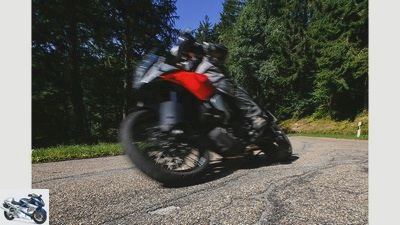
Monnich
3/33
Anyone who wants to bring a lot of power to the ground on bad roads will find the best engine and chassis requirements for this on the KTM.

Monnich
4/33
Depending on requirements, the electronics also moderate the temperament of your engine and the functionality of the ABS, right up to off-road use.
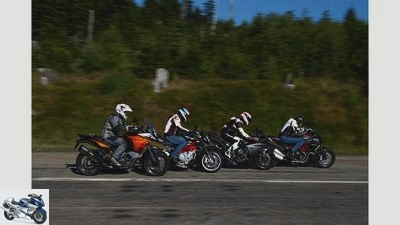
Monnich
5/33
This time the comparison is all about performance and development.
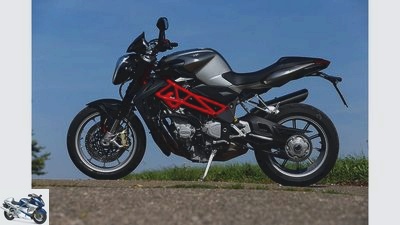
Monnich
6/33
Nobody would build a four-cylinder as elaborately as with the MV Agusta Brutale 1090 today: radial valves, conically ground cams, camshaft drive between the cylinders, alternator behind in favor of a narrow design, cassette gear.

Monnich
7/33
The MV is short and handy, the seating position on it provides a good overview of the game.

Monnich
8/33
The camshaft drive is not on the side. It sits like a skin
Cover over the coupling.

MV Agusta
9/33
One of the many special features of the MV motor: radially arranged valves.
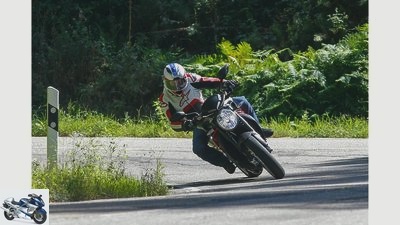
Monnich
10/33
Surf through alternating curves in a middle gear and accelerate vigorously without much gear change – the high-torque engine makes it possible.

Monnich
11/33
The MV engine is a wonderful anachronism.
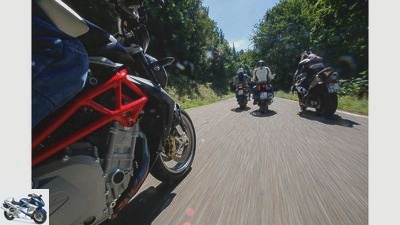
Monnich
12/33
The Ducati and MV Agusta in particular were able to score points.
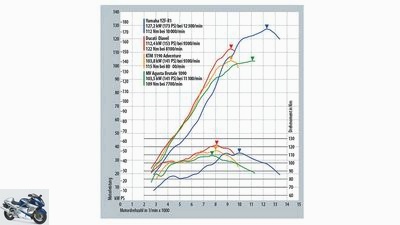
Monnich
13/33
Measuring the performance of the motorcycles tested.

Monnich
14/33
The measured power on the rear wheel.
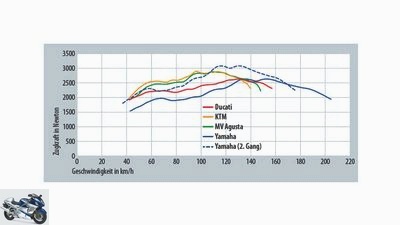
Monnich
15/33
The traction in 3rd gear.
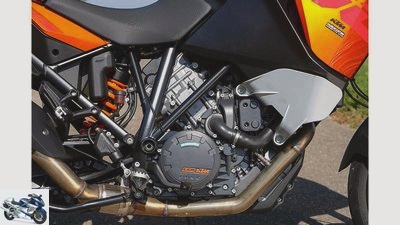
Monnich
16/33
The narrow cylinder angle for compact dimensions. Reinforcing ribs arranged according to the load.
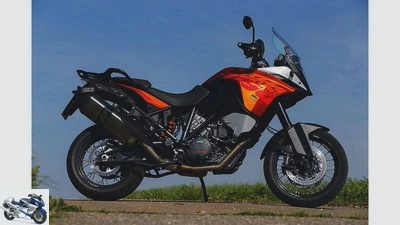
Monnich
17/33
Because of its height, accelerating, braking and changing lean angles are an intense experience on the KTM.
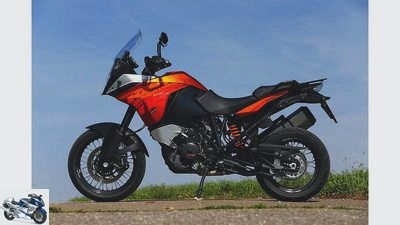
Monnich
18/33
The KTM 1190 Adventure belongs to the travel enduro category, but it is a real all-rounder.

Monnich
19/33
For super athletes like the Yamaha YZF-R1, the focus is on efficiency, also in terms of aerodynamics.
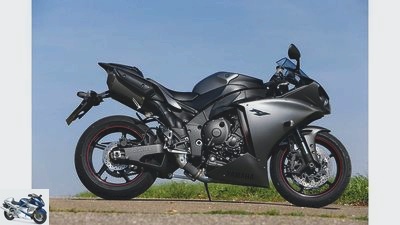
Monnich
20/33
As one of the last athletes, the R1 still has a raised exhaust system.

Monnich
21/33
The exhaust manifold serves as an indication of the unusual firing order. The performance of the cooling system is tight.
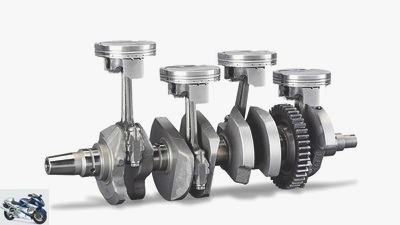
Yamaha
22/33
The Yamaha crossplane crankshaft – so called because its crankpins are not on the same level as they normally would.
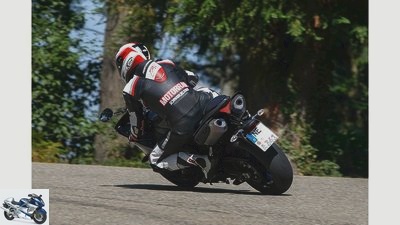
Monnich
23/33
Like all modern super sports bikes, the R1 is a motorcycle for higher speeds and wider curve radii. The first gear reaches up to 145 km / h.
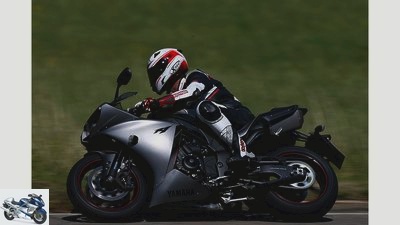
Monnich
24/33
The Yamaha powerhouse certainly has its charms, which are only slightly impaired by water hoses, cables and cables.
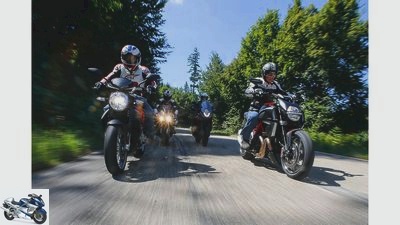
Monnich
25/33
A comparison at this level would not have been possible 20 years ago. Only tuned supersport motorcycles could manage 150 hp.
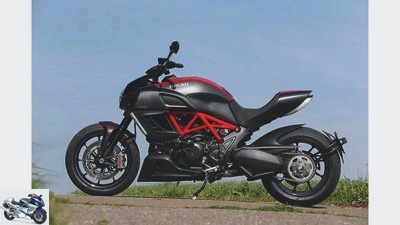
Monnich
26/33
Even if it hardly plays a role in this story: The Ducati Diavel Carbon can take turns – and it does so quickly. Nevertheless, her main interest is rather straightforward.
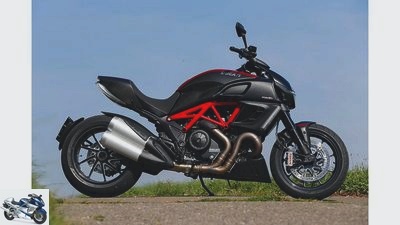
Monnich
27/33
With a lot of weight on the front wheel and a long wheelbase, you can accelerate explosively.
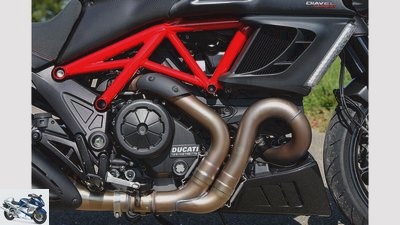
Monnich
28/33
The oil bath clutch grabs vigorously and the almost arm-thick manifold has a lot of power to offer.
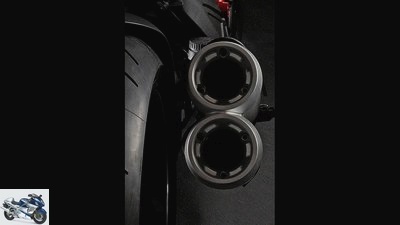
Ducati
29/33
When the Diavel shoots into the area through its sound cannons, people turn around.
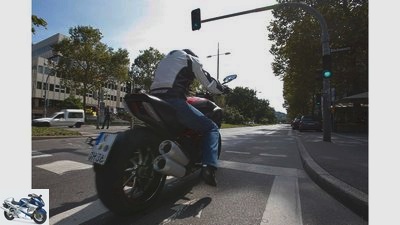
Monnich
30/33
With the Diavel, every traffic start turns into a drag race. She just can’t do anything else, and after a while the driver can’t do anything else either.
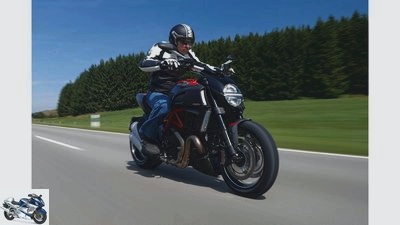
Monnich
31/33
At Vmax, however, the Ducati Diavel Carbon only has two upshifts.

Monnich
32/33
The manufacturers have retrofitted vigorously in all categories.
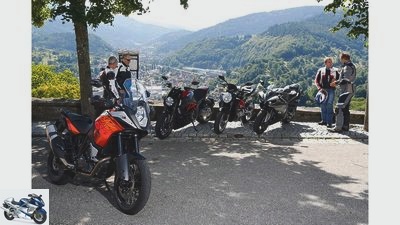
Monnich
33/33
In everyday use, however, the KTM delivers the best performance to the road thanks to its excellent suspension elements, while the Diavel cannot handle bumps very well. Unfortunately, the Yamaha can rarely develop power and sound away from the motorway and racetrack.
MV Agusta Brutale 1090, KTM 1190 Adventure, Yamaha YZF-R1 and Ducati Diavel Carbon in the test
Concept comparison of naked bikes, enduro, athletes and cruisers
In which motorcycle concept is performance the most fun to ride? MOTORRAD tests the naked bike MV Agusta Brutale 1090, the Enduro KTM 1190 Adventure, the athlete Yamaha YZF-R1 and the power cruiser Ducati Diavel in comparison.
Concept comparison
A comparison at this level would not have been possible 20 years ago. Only tuned supersport motorcycles created 150 hp; the Suzuki GSX-R 1100 W, which claimed to produce 155 hp from 1995 onwards, towered far beyond the other series-produced motorcycles and has rarely really had them. Also some examples of the legendary first Yamaha YZF-R1 from 1998 stayed below the stated 150 PS, but the force of the high-torque four-cylinder in a motorcycle weighing just 208 kilograms provided impressive experiences of sheer motor power. Experiencing similar demonstrations of force on a naked bike, a travel enduro or even a cruiser was simply unthinkable at the time.
Buy complete article
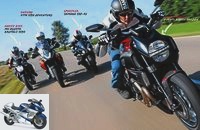
MV Agusta Brutale 1090, KTM 1190 Adventure, Yamaha YZF-R1 and Ducati Diavel Carbon in the test
Concept comparison of naked bikes, enduro, athletes and cruisers
Manufacturers have upgraded vigorously in all categories
Today it’s very different. The manufacturers have retrofitted vigorously in all categories. Today’s Yamaha YZF-R1 is by no means the strongest athlete and yet it pushes a whopping 173 hp on the test bench. The class of undisguised motorcycles was the first to benefit directly from super athletes of this caliber. Many of them have modified sports engines with increased torque in the lower speed range, such as the Aprilia Tuono, Ducati Monster S4 or Honda CB 1000 R. The MV Agusta Brutale 1090 for this comparison also got its drive from the F4 series.
Based on the 1190 sports engine, Ducati opened up new dimensions in two segments with the Multistrada and the Diavel: for travel enduros / fun bikes and for cruisers. As the undisputed leader of its class, the Ducati Diavel also competes in this concept comparison. The latest example of the technology transfer initiated by the athletes is the KTM 1190 Adventure, whose engine is derived from the superbike power plant of the IDM winner RC8 R..
R1 engine with good response and load change behavior
Monnich
As one of the last athletes, the R1 still has a raised exhaust system.
Quantity is not everything. The performance development also achieves new qualities. Like many others, this development, inspired by racing, began with the super athletes. The measured 173 PS of the current Yamaha YZF-R1 unfold more cultivated and easier to control than the almost 150 of the predecessor. The flow of power that the motor gives to the rear wheel only gets really fast in the range of five-digit speeds. The driver must consciously visit this area. So he is prepared for what will happen, while the steeply increasing torque of the “old” R1 even at a leisurely 4000 rpm surprised some drivers – and overwhelmed some rear tires when accelerating in an inclined position.
In this upwardly brushed power development of the current Yamaha YZF-R1, the physical law manifests itself that with the same cubic capacity and the same number of cylinders, more power can only be achieved through better filling at higher speeds. In a direct comparison of the curves, it is nice to see that the Yamaha MV four-cylinder engine clearly outperforms it only beyond 8300 rpm. On the other hand, the characteristic is also determined by the experience of 15 years of model development. And it teaches that a lot of power can be used most safely when it increases linearly and in a predictable manner. This is guaranteed by the R1 engine, which also spoils you with good response and load change behavior. With minor differences and depending on the selected driving mode, the other three candidates also demonstrate the high level of development in this important discipline.
Monnich
With a lot of weight on the front wheel and a long wheelbase, the Ducati Diavel Carbon can accelerate explosively.
A glance at the bundle of curves also gives an idea of what the comparison drives confirmed: When accelerating in the everyday relevant speed range of 30 to 130 km / h, the Yamaha YZF-R1 has a hard time following the three other motorcycles. These all develop more torque in the lower speed range, which in the case of the MV Agusta Brutale 1090 is supported by an almost eight-percent increase in displacement, and in the two-cylinder Ducati Diavel and KTM 1190 Adventure by a 20 percent increase in displacement. The Yamaha is the strongest and fastest of the four motorcycles, but it can only play that on unlimited motorway sections or on the racetrack.
Even in third gear, all the machines drive around 150 km / h
Monnich
The traction in 3rd gear.
It is not just the power delivery that is responsible for this, but also the gear ratio. As is typical for athletes and ideal for most racetracks, the first gear of the Yamaha YZF-R1 has a very long gear ratio. The following gears are then more closely connected, and from fourth gear the R1 gearbox is even less geared than the corresponding gear stages of Ducati Diavel, KTM 1190 Adventure and MV Agusta Brutale 1090. But already in third gear, all the machines are running when they are turned down Engines around 150 km / h or faster, the Yamaha even cracks the 200 km / h limit in the third. The upper gears are mainly used to save fuel in everyday operation.
The exact opposite of the R1 gradation is represented by the transmission of the KTM 1190 Adventure. In favor of better off-road and alpine road suitability, it was given very short lower gears. What that means for the accelerating power on the rear wheel: Full torque and a short gear ratio give the KTM 1190 Adventure in particular a great advantage in the range between 50 and 130 km / h. The 0.4 seconds that she loses in the acceleration up to 140 km / h on the Diavel, she has earned earlier. The MV Agusta Brutale 1090, thanks to an equally short overall gear ratio, and the Ducati Diavel follow in the places; the Yamaha needs a lower gear and higher engine speeds to keep up. To make this clear, the traction diagram also shows the traction curve of the Yamaha in second gear as a dashed line.
Monnich
The KTM 1190 Adventure belongs to the travel enduro category, but it is a real all-rounder.
When it is tickled in the upper speed range, the Yamaha YZF-R1 tears quite violently. Thanks to the crouched sitting position, this speed can be ridden out easily, but when braking before the next bend it becomes exhausting because the driver has to support a large part of his weight with his arms. A smooth sequence of maneuvers can only be achieved with great commitment. It is easier to drive quickly with the others.
The diagrams shown here only explain the full load portion of the complex issue of performance and how it is felt when driving. Whereby we don’t know exactly when full load is actually applied. Because on all four motorcycles the electronics regulate important performance-determining parameters such as throttle valve position or ignition timing. The engine is not always allowed to give it its all when the driver has the throttle on the stop. This can be seen very clearly in a direct comparison of different driving modes. Take the KTM 1190 Adventure, for example: In “Street” mode, the “full throttle” performance curve in the medium engine speed range is up to 5 hp below that of “Sport” mode, and only catches up with the “Sport” curve from 6000 rpm , but achieves the same maximum performance. That can only mean that the engine is slowed down in certain areas in favor of smoother power delivery. The difference in acceleration behavior, the subjective feeling of power, differs between the two modes more than the measured values suggest. In “Street” mode, the KTM resembles the Yamaha characteristics, while in “Sport” mode it zooms in on the Ducati Diavel.
Monnich
The MV Agusta Brutale 1090 is short and handy, the seating position on it allows a good overview of the game.
The partial load range, in which most people mostly drive, can only be expressed in numbers with the most complex measurement technology, and here the electronics are more active than at full load. It acts as a kind of translator for the throttle commands. And just as there can be variations in translations from one language to the other, the power and the way it is delivered vary depending on the driving mode. In addition to the standard mode, which also allows full power ahead, the Yamaha YZF-R1 offers the “A"-Mode that shows a more aggressive response and a “B"-Mode that allows less peak power and allows the engine to respond particularly smoothly. On winding roads with many load changes, the more aggressive “A"-Modus is the better choice, but the gentler “B"-Mode. It shows how you can actually drive more relaxed and thus perhaps even faster with less power.
The Ducati Diavel affects the psyche of its drivers with all available means. This goes up to the feeling of hanging on the handlebars when accelerating and only being saved from fluttering by the seat recess. But first and foremost – and that makes the Diavel extremely likeable – it convinces with actions, not just with data. As hard as she accelerates, it was clear to everyone that her V2 pushes the highest torque everywhere. Except for two areas where your curve is briefly outstripped by those of the MV and the KTM 1190 Adventure, this is actually the case.
The explosive midrange power distinguishes the Testastretta Evoluzione of the Ducati Diavel from the almost identical engine of the Multistrada 1200. Its characteristics fit seamlessly with the muscular exterior of the motorcycle. “Street” and “Sport” modes hardly differ significantly in the almost attack-like acceleration; Only the “Urban” mode makes the Ducati Testastretta noticeably smoother. The test consumption of the MV Agusta suggests – it is traditionally high for the Brutale models – that it is motivated to accelerate with ample mixture enrichment in the partial load range.
In fact, however, the “Street” and “Race” modes differ in that the opening curve of the throttle valve is slightly different, but above all in that the ignition is adjusted more quickly in the early direction, which creates a more aggressive characteristic. Because she lets off steam in a motorcycle with a rather short wheelbase, the driver of which is also sitting upright, the MV Agusta Brutale 1090 cannot accelerate as quickly as the Ducati Diavel – there is a risk of rollover. But as with the Alpine Masters, it shines with the best torque values. By the way: Your elaborately designed four-cylinder with radially arranged valves and the alternator located behind the cylinder bank works in the test machine from MOTORRAD as cultivated as hardly any of its predecessors. Its vibrations are never annoying, and the mechanical noises are more subtle than on previous test machines.
With the Ducati Diavel, nobody has to listen carefully. It shoots the area through its sound cannons quite unabashedly and thus supports the subjective feeling of motor omnipotence that makes Diavel driving a special experience. It’s the good old-fashioned effect: what sounds strong must also be strong. This feeling has often been deceptive, but in contrast to many tuning exhaust systems, the Diavel keeps what it loudly promises. However, the KTM 1190 Adventure delivers no less power and hardly less torque and consumes the least gasoline without having to constantly raise one’s voice.
The main thing is that the overall system works
Monnich
A comparison at this level would not have been possible 20 years ago. Only tuned supersport motorcycles could manage 150 hp.
In the ears of most motorcyclists, two-cylinder have a nicer, stronger sound than four-cylinder. Their sound at higher speeds is often described as uncomfortably bright and screeching. If you are bothered by it, you should definitely test drive the Yamaha YZF-R1. With its unusual, uneven firing order, it acts as an in-line engine like a V4. In this way, it creates a sound that is not perceived as hectic, but at higher speeds, as the sound gradually becomes harder, it creates a wonderful tingling sensation. Whether the unusual firing order is actually a reason for the feeling of the load change behavior, or whether it is simply due to a particularly successful set-up, cannot be said without a doubt. The main thing is that the overall system works. And it does.
As the second four-cylinder in the field, the MV engine has a conventional crankshaft, and all cylinders fire at equal intervals. Nevertheless, you don’t have to count him among the screamers when it comes to sound. On the contrary: the MV Agusta developers have succeeded in creating a “Dark Ground Voice” for him, a voice with a dark background, which can produce impressive-sounding interference effects, especially in urban canyons. And a sense of cultivated power.
Today, taking over a basic engine from one series to another is anything but an act of convenience. It goes without saying that it saves costs if a manufacturer does not have to redevelop the mechanical parts of an engine from scratch. But it is now standard even with smaller manufacturers to carefully adapt many details to the specific requirements of their new segment. It starts with the performance characteristics and goes through the response and load change behavior, the transmission and overall gear ratio to the sound of the exhaust system. In the case of the four motorcycles in this concept comparison, this was consistently successful.
Conclusion
It’s all about performance and its development, and here the Ducati offers the highest experience value, followed by the MV Agusta Brutale 1090. In everyday use, however, the KTM 1190 Adventure, thanks to its excellent suspension elements, delivers the best performance to the road, while the Ducati Diavel is not good at handling bumps. Unfortunately, the Yamaha YZF-R1 can rarely develop power and sound away from the motorway and racetrack.
Ducati Diavel Carbon
Monnich
At Vmax, the Ducati Diavel Carbon only has two upshifts.
| engine | |
| design type | Two cylinder four stroke 90 degree V engine |
| injection | Ø 56 mm |
| coupling | Multi-disc oil bath clutch (Anti-hopping) |
| Bore x stroke | 106.0 x 67.9 mm |
| Displacement | 1198 cc |
| compression | 11.5: 1 |
| power | 112.7 kW (153 hp) at 9500 rpm |
| Torque | 128 Nm at 8000 rpm |
| landing gear | |
| frame | Steel tubular frame |
| fork | Upside-down fork, Ø 50 mm |
| Steering damper | – |
| Brakes front / rear | Ø 320/265 mm |
| Assistance systems | ABS, traction control |
| bikes | 3.50 x 17; 8.00 x 17 |
| tires | 120/70 ZR 17; 240/45 ZR 17 |
| Tires | Pirelli Diablo Rosso II, front “D” |
| mass and weight | |
| wheelbase | 1590 mm |
| Steering head angle | 62.0 degrees |
| trailing | 130 mm |
| Front / rear suspension travel | 120/120 mm |
| Seat height * | 770 mm |
| Weight with full tank * | 238 kg |
| Payload * | 162 kg |
| Tank capacity / reserve | 17.0 / 4.0 liters |
| Service intervals | 12,000 km |
| price | 20,590 euros |
| Price test motorcycle | 20,590 euros |
| Additional costs | 305 euros |
| MOTORCYCLE readings | |
| Top speed² | 225 km / h |
acceleration
0-100 km / h
0-140 km / h
0-200 km / h
4.9 sec
9.5 sec
60-100 km / h
100-140 km / h
140-180 km / h
3.6 sec
3.9 sec
* MOTORCYCLE measurements; ² manufacturer information; ³Price including EDS (electronically adjustable chassis), TPMS (tire pressure monitoring) and main stand (800 euros) and heated grips (197 euros)
KTM 1190 Adventure
Monnich
Anyone who wants to bring a lot of power to the ground on bad roads will find the best engine and chassis requirements for this on the KTM.
| engine | |
| design type | Two-cylinder four-stroke 75 degree V engine |
| injection | Ø 52 mm |
| coupling | Multi-disc oil bath clutch (Anti-hopping) |
| Bore x stroke | 105.0 x 69.0 mm |
| Displacement | 1195 cc |
| compression | 12.5: 1 |
| power | 110.0 kW (150 PS) at 9500 rpm |
| Torque | 125 Nm at 7500 rpm |
| landing gear | |
| frame | Steel tubular frame, engine supporting |
| fork | Upside-down fork, Ø 48 mm |
| Steering damper | hydraulically |
| Brakes front / rear | Ø 320/267 mm |
| Assistance systems | Compound brake, ABS, traction control |
| bikes | 3.50 x 19; 5.00 x 17 |
| tires | 120/70 ZR 19; 170/60 ZR 17 |
| Tires | Continental TrailAttack 2 “K” |
| mass and weight | |
| wheelbase | 1560 mm |
| Steering head angle | 64.0 degrees |
| trailing | 120 mm |
| Front / rear suspension travel | 190/190 mm |
| Seat height * | 860-875 mm |
| Weight with full tank * | 238 kg |
| Payload * | 202 kg |
| Tank capacity / reserve | 23.0 / 3.5 liters |
| Service intervals | 15000 km |
| price | 13,995 euros |
| Price test motorcycle | 14,992 euros³ |
| Additional costs | 250 euro |
| MOTORCYCLE readings | |
| Top speed² | 250 km / h |
acceleration
0-100 km / h
0-140 km / h
0-200 km / h
5.6 sec
10.9 sec
60-100 km / h
100-140 km / h
140-180 km / h
3.6 sec
4.1 sec
* MOTORCYCLE measurements; ² manufacturer information; ³Price including EDS (electronically adjustable chassis), TPMS (tire pressure monitoring) and main stand (800 euros) and heated grips (197 euros)
MV Agusta Brutale 1090
Monnich
Surf through alternating curves in a middle gear and accelerate vigorously without much gear change – the high-torque engine makes it possible.
| engine | |
| design type | Four-cylinder, four-stroke in-line engine |
| injection | Ø 46 mm |
| coupling | Multi-disc oil bath clutch (Anti-hopping) |
| Bore x stroke | 79.0 x 55.0 mm |
| Displacement | 1078 cc |
| compression | 13.0: 1 |
| power | 106.0 kW (144 hp) at 10600 rpm |
| Torque | 112 Nm at 8100 rpm |
| landing gear | |
| frame | Steel tubular frame, engine supporting |
| fork | Upside-down fork, Ø 50 mm |
| Steering damper | – |
| Brakes front / rear | Ø 320/210 mm |
| Assistance systems | ABS, traction control |
| bikes | 3.50 x 17; 6.00 x 17 |
| tires | 120/70 ZR 17; 190/55 ZR 17 |
| Tires | Pirelli Diablo Rosso II, front “K” |
| mass and weight | |
| wheelbase | 1438 mm |
| Steering head angle | 65.0 degrees |
| trailing | 104 mm |
| Front / rear suspension travel | 125/120 mm |
| Seat height * | 825 mm |
| Weight with full tank * | 214 kg |
| Payload * | 179 kg |
| Tank capacity / reserve | 23.0 / 4.0 liters |
| Service intervals | 6000 km |
| price | 13590 euros |
| Price test motorcycle | 13590 euros |
| Additional costs | 275 euros |
| MOTORCYCLE readings | |
| Top speed² | 265 km / h |
acceleration
0-100 km / h
0-140 km / h
0-200 km / h
5.4 sec
9.8 sec
60-100 km / h
100-140 km / h
140-180 km / h
3.0 sec
3.4 sec
* MOTORCYCLE measurements; ² manufacturer information; ³Price including EDS (electronically adjustable chassis), TPMS (tire pressure monitoring) and main stand (800 euros) and heated grips (197 euros)
Yamaha YZF-R1
Monnich
The Yamaha powerhouse certainly has its charms, which are only slightly impaired by water hoses, cables and cables.
| engine | |
| design type | Four-cylinder, four-stroke in-line engine |
| injection | Ø 45 mm |
| coupling | Multi-disc oil bath clutch (Anti-hopping) |
| Bore x stroke | 78.0 x 52.2 mm |
| Displacement | 998 cc |
| compression | 12.7: 1 |
| power | 133.9 kW (182 hp) at 12500 rpm |
| Torque | 116 Nm at 10000 rpm |
| landing gear | |
| frame | Bridge frame made of aluminum |
| fork | Upside-down fork, Ø 43 mm |
| Steering damper | hydraulically |
| Brakes front / rear | Ø 310/220 mm |
| Assistance systems | Traction control |
| bikes | 3.50 x 17; 6.00 x 17 |
| tires | 120/70 ZR 17; 190/55 ZR 17 |
| Tires | Dunlop Sportmax Qualifier, front “MT” |
| mass and weight | |
| wheelbase | 1415 mm |
| Steering head angle | 66.0 degrees |
| trailing | 102 mm |
| Front / rear suspension travel | 120/120 mm |
| Seat height * | 820 mm |
| Weight with full tank * | 215 kg |
| Payload * | 180 kg |
| Tank capacity / reserve | 18.0 / – liters |
| Service intervals | 10000 km |
| price | 15,995 euros |
| Price test motorcycle | 15,995 euros |
| Additional costs | 295 euros |
| MOTORCYCLE readings | |
| Top speed² | 285 km / h |
acceleration
0-100 km / h
0-140 km / h
0-200 km / h
4.7 sec
7.8 sec
60-100 km / h
100-140 km / h
140-180 km / h
3.5 sec
3.6 sec
* MOTORCYCLE measurements; ² manufacturer information; ³Price including EDS (electronically adjustable chassis), TPMS (tire pressure monitoring) and main stand (800 euros) and heated grips (197 euros)
Related articles
-
Comparison test: MV Agusta Brutale 1090 RR and Ducati Streetfighter S
fact comparison test: Italian naked bikes, Ducati Streetfighter S, MV Agusta Brutale 1090 RR MV Agusta Brutale 1090 RR and Ducati Streetfighter S …
-
Comparison test: Ducati Diavel, Suzuki B-King and Yamaha Vmax
Jahn comparison test: Power Bikes 2011 Ducati Diavel, Suzuki B-King and Yamaha Vmax Content from Big appearance, powerful sound waves, pressure from all …
-
39 pictures 1/39 The Triumph Speed Triple: The price 11,740 euros (the test motorcycle with windshield for 245 euros and …
-
Ducati Panigale, Ducati Multistrada, KTM RC8, KTM 1190 Adventure in the test
Kunstle 26 pictures 1/26 Ducati Multistrada 1200 S, Ducati 1199 Panigale S, KTM 1190 Adventure and KTM 1190 RC8 R in enduro / supersport bikes …
-
Comparison test BMW R 1200 GS Adventure, Ducati Multistrada 1200 Enduro, KTM 1190 Adventure R.
Tanja O’Kelly 37 pictures mio-fotografie.de 1/37 A comparison test of a different kind with the large enduro bikes BMW R 1200 GS Adventure, Ducati Multistrada 1200 …
-
Comparison test Ducati Monster 821 Stripe, MV Agusta Brutale 800 and Yamaha XSR 900
r-photography.info 45 pictures 1/45 Yamaha XSR 900. 2/45 MV Agusta Brutale 800. 3/45 …
-
Honda CB 1000 R, MV Agusta Brutale 1090 RR ABS and Triumph Speed Triple R in the test
34 photos www. 1/34 The four-cylinder of the MV Agusta Brutale 1090 RR is extremely easy to turn, from which it draws its high…
-
Gargolov 10 pictures Ducati 1/10 Ducati Diavel Carbon: The Italians officially presented their Power Cruiser at the Eicma. The Testastretta 11 ° engine …
-
Ducati Diavel Carbon and MV Agusta Brutale 800 Dragster in the test
Gargolov 19 pictures Gargolov 1/19 photo production from the comparison test between Ducati Diavel Carbon and MV Agusta Brutale 800 Dragster. The test is available in MOTORRAD …
-
BMW F 800 R, Kawasaki Z 800, MV Agusta Brutale 800 and Yamaha FZ8 in the test
Jahn 29 photos Jahn 1/29 A comparison of four 800 class motorcycles: BMW F 800 R, Kawasaki Z 800, MV Agusta Brutale 800 and Yamaha FZ8. Jahn 2/29 Like…